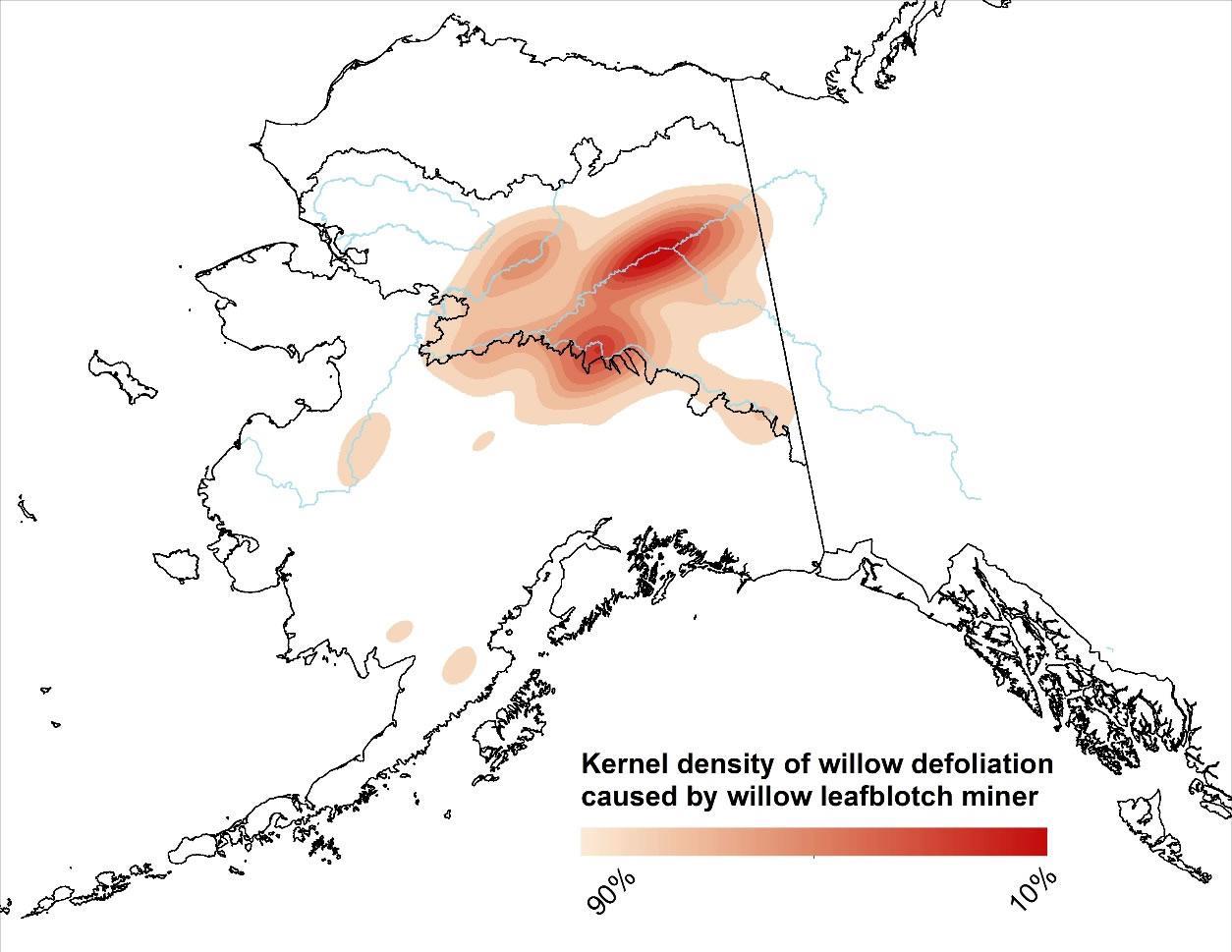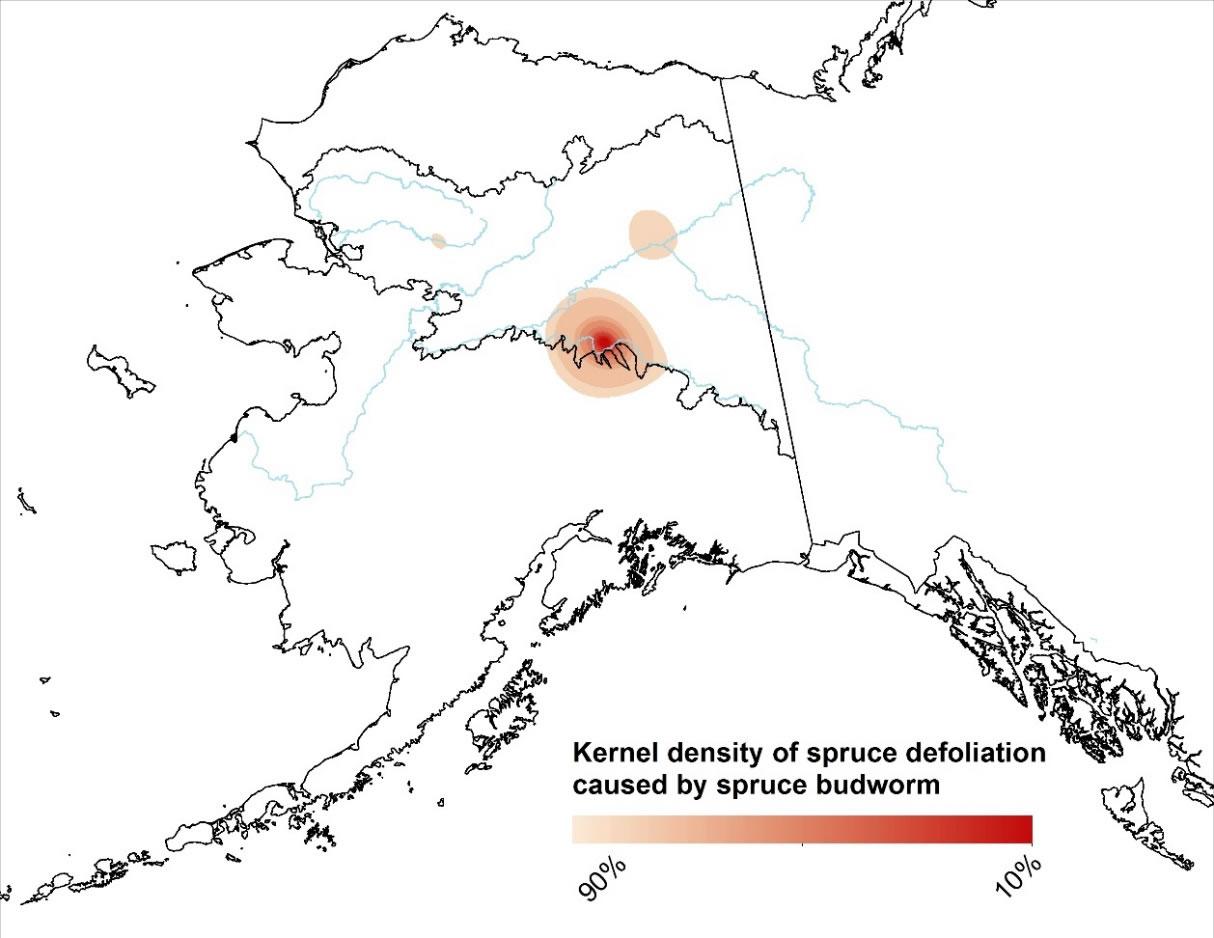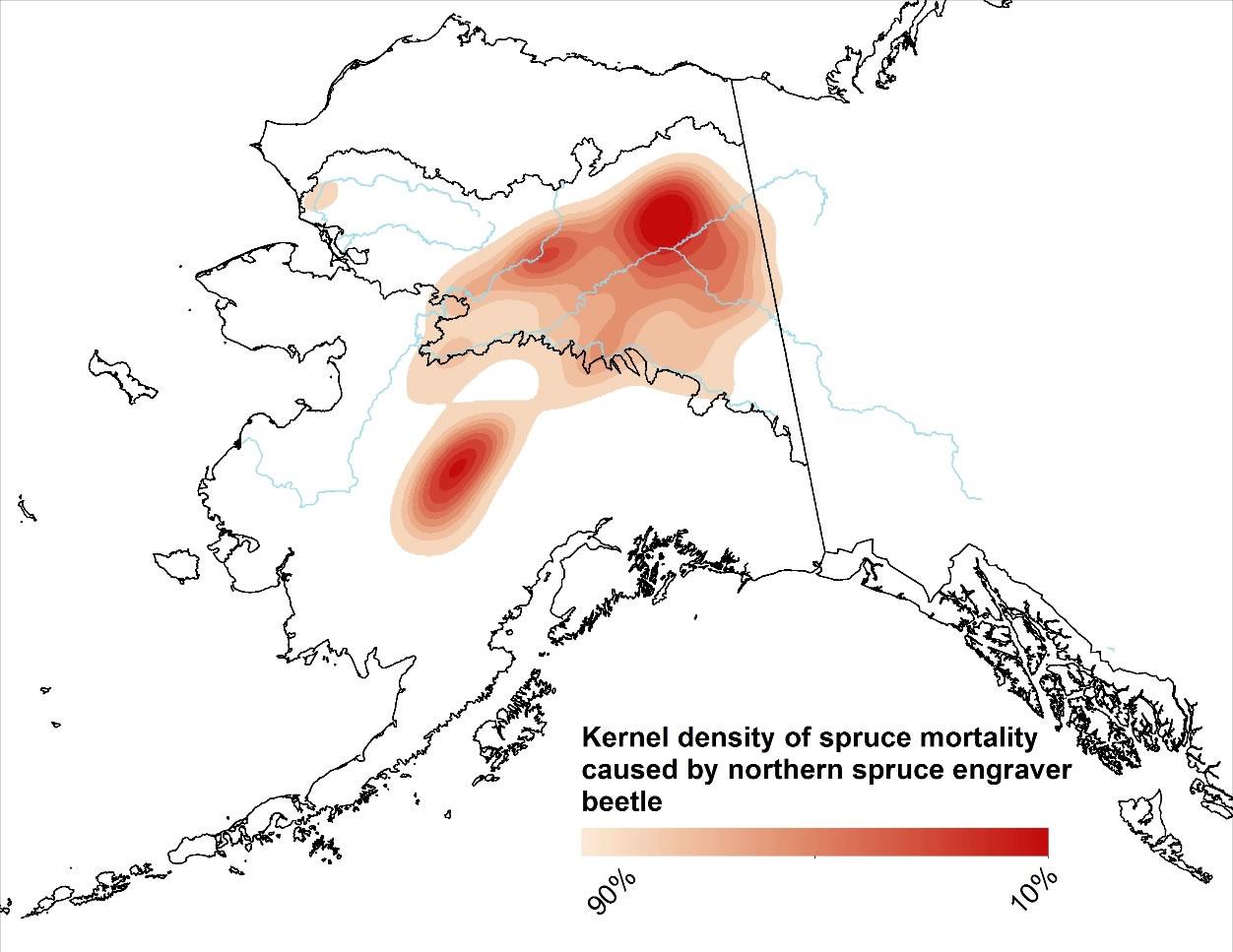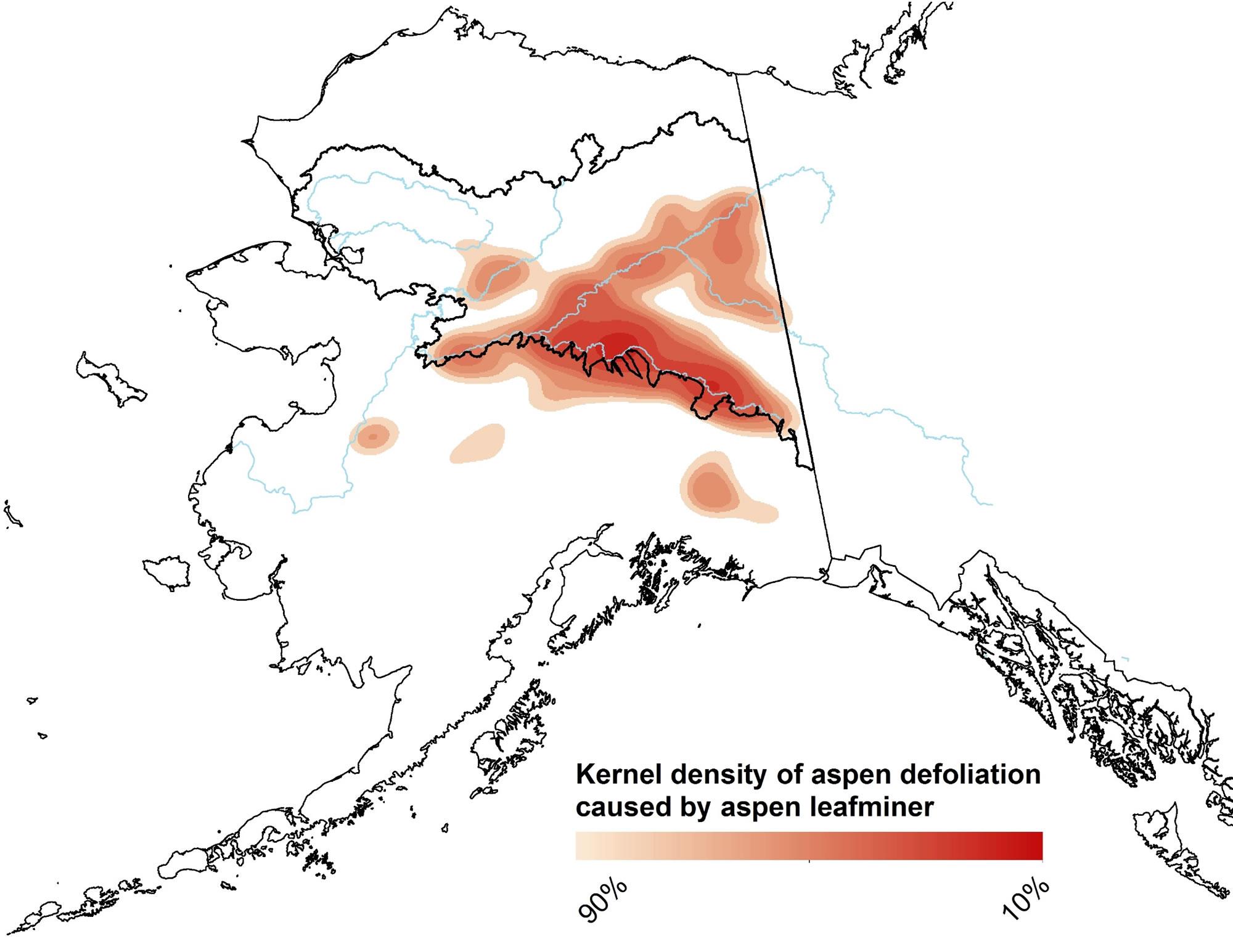The four host/damage type combinations that have contributed the largest areas of forest damage within the study area were correlated to their causal agent(s). Area of forest damage was calculated and described for each of the four most prevalent host/damage type combinations at five year intervals from 2000 to 2014. Severity of damage for the entire 15-year period from 2000 to 2014 was summarized for insect agents that had associated severity data.
Kernel Density of Willow Defoliation Caused by Willow Leafblotch Miner
From 1991 to 1993, willow leafblotch miner defoliated large areas of willow along the Yukon and Kuskokwim Rivers. From 1998 to 1999, a regional willow leafblotch miner outbreak occurred around the Yukon Flats National Wildlife Refuge. Defoliation has occurred on numerous tall and low shrub willow species with the notable exception of felt-leaf willow, which is protected by dense hairs on lower leaf surfaces. The defoliation of willow caused by willow leafblotch miner accounted for over 20% of observed forest damage by area from 2000 to 2014. The area of observed willow defoliation doubled every 5-year period from 2000 to 2014. From 2010 to 2014, approximately 40% of observed forest damage was caused by willow leafblotch miner. This may indicate that environmental conditions are becoming more favorable for willow leafblotch miner within the study area. Most of the defoliation caused by willow leafblotch miner in Alaska occurred within the study area, although more sporadic, widely separated defoliation sites occurred throughout the state. Kernel Density Estimation was performed using Geospatial Modeling Environment (GME) with points of aspen defoliation damage from 2000 to 2014. The raw kernel density output was interpolated as 5% quantiles of the kernel density values extracted to the original input points. This dataset provides a visualization of area and intensity of impact of aspen leafminer within Alaska from 2000 to 2014.
Kernel Density of Damage Caused by Spruce Budworm
Spruce defoliation caused by spruce budworm accounted for 6% of observed forest damage by area from 2000 to 2014. However, most of the observed spruce defoliation (around 85%) was low severity (less than half of spruce within damage polygon were defoliated). Spruce budworm did not cause large areas of forest damage from 2010 to 2014: spruce defoliation was relatively high from 2000 to 2004 and 2005 to 2009, and then dropped to almost undetected levels from 2010 to 2014. Spruce budworm outbreaks from 2000 to 2014 were concentrated in areas along the Tanana River near Fairbanks and around the confluence of the Porcupine and Yukon rivers. An additional small aggregation of spruce budworm damage was located on the Kobuk River. Only sporadic, widely separated outbreaks occurred outside these areas. Kernel Density Estimation was performed using Geospatial Modeling Environment (GME) with points of spruce defoliation damage from 2000 to 2014. The raw kernel density output was interpolated as 5% quantiles of the kernel density values extracted to the original input points. This dataset provides a visualization of area and intensity of impact of spruce budworm within Alaska from 2000 to 2014.
Kernel Density of Spruce Mortality Caused by Spruce Beetle
White spruce has been the most susceptible tree or shrub to mortality from insect and disease agents within the study area. Severity of damage has not been consistently identified for spruce mortality. While spruce beetle outbreaks have caused severe, regional spruce mortality in Southcentral Alaska, spruce beetles have caused only localized and sporadic damage in Interior Alaska. From 2000 to 2014, relatively little spruce beetle damage occurred within the study area. A small region of the 90% isopleth existed along the Yukon River upstream from the confluence with the Porcupine River. However, none of the 80% to 10% isopleths included any area within the study area, and spruce beetle activity was limited north of the eastern and central Alaska Range. From 1990 to 2014, spruce beetle caused only 370 sq km of spruce mortality. This long-term trend suggests that environmental conditions in the study area have historically prevented severe, regional spruce beetle outbreaks. Despite outbreaks being uncommon in the study area, spruce beetles are present in stressed or dying spruce throughout Interior Alaska. Spruce mortality caused by both spruce beetle and northern spruce engraver beetle remained the dominant form of mortality from 2010 to 2014. Kernel Density Estimation was performed using Geospatial Modeling Environment (GME) with points of spruce beetle damage from 2000 to 2014. The raw kernel density output was interpolated as 5% quantiles of the kernel density values extracted to the original input points. This dataset provides a visualization of area and intensity of impact of spruce beetle within Alaska from 2000 to 2014.
Kernel Density of Spruce Mortality Caused by Northern Spruce Engraver Beetle
White spruce has been the most susceptible tree or shrub to mortality from insect and disease agents within the study area, but the severity of its damage has not been consistently identified. Northern spruce engraver beetle caused approximately 5 times more observed damage by area than spruce beetle. Much of the spruce mortality caused by northern spruce engraver beetle in Alaska fell within the study area, with a high density of the damage occurring north of the confluence of the Porcupine and Yukon Rivers. Northern spruce engraver beetle damage occurred along the lower Noatak River and sporadically throughout the length of the Kobuk River. Spruce mortality caused by both spruce beetle and northern spruce engraver beetle remained the dominant form of mortality from 2010 to 2014, with the northern spruce engraver beetle continuing to contribute more mortality than spruce beetle during those 4 years. The area of spruce mortality caused by northern spruce engraver beetle increased by more than five times between 2000 to 2004 and 2005 to 2009. During 2010 to 2014, activity of northern spruce engraver beetle declined from the amount observed from 2005 to 2009, though not to the levels of 2000 to 2004. Kernel Density Estimation was performed using Geospatial Modeling Environment (GME) with points of spruce damage from 2000 to 2014. The raw kernel density output was interpolated as 5% quantiles of the kernel density values extracted to the original input points. This dataset provides a visualization of area and intensity of impact of northern spruce engraver beetle within Alaska from 2000 to 2014.
Kernel Density of Aspen Defoliation Caused by Aspen Leaf Miner
The defoliation of quaking aspen (Populus tremuloides) caused by aspen leaf miner (Phyllocnistis populiella) accounted for over 60% of observed forest damage by area from 2000 to 2014 within the study area. Approximately 40% of aspen defoliation by area was high severity (over half of aspen within the damage polygon were defoliated). From 2010 to 2014, quaking aspen defoliation remained one of the major forms of insect- and disease-related forest damage and accounted for approximately 45% of observed forest damage by area. The area of quaking aspen defoliation has fluctuated every 5-year period between 2000 and 2014 (i.e. 2000 to 2004, 2005 to 2009, and 2010 to 2014) but has always remained the most common form of insect- and disease-related forest damage by area within the study area. The consistently high area of quaking aspen defoliation suggests that environmental conditions steadily favor high populations and/or frequent outbreaks of aspen leaf miner. Temperature and precipitation have, among other environmental factors, driven the distribution of aspen leaf miner in Alaska. Most aspen defoliation caused by aspen leaf miner in Alaska from 2000 to 2014 occurred within the study area. Kernel Density Estimation was performed using Geospatial Modeling Environment (GME) with points of aspen defoliation damage from 2000 to 2014. The raw kernel density output was interpolated as 5% quantiles of the kernel density values extracted to the original input points. This dataset provides a visualization of area and intensity of impact of aspen leafminer within Alaska from 2000 to 2014.
35 files in this archive
- CYR_IV_H_AspenLeafminerDamageDensity_2000to2014.img
- CYR_IV_H_AspenLeafminerDamageDensity_2000to2014.img.aux.xml
- CYR_IV_H_AspenLeafminerDamageDensity_2000to2014.img.vat.dbf
- CYR_IV_H_AspenLeafminerDamageDensity_2000to2014.lyr
- CYR_IV_H_AspenLeafminerDamageDensity_2000to2014.xml
- CYR_IV_H_InsectAndDiseaseSummary_2000to2014.cpg
- CYR_IV_H_InsectAndDiseaseSummary_2000to2014.dbf
- CYR_IV_H_InsectAndDiseaseSummary_2000to2014.lyr
- CYR_IV_H_InsectAndDiseaseSummary_2000to2014.prj
- CYR_IV_H_InsectAndDiseaseSummary_2000to2014.sbn
- CYR_IV_H_InsectAndDiseaseSummary_2000to2014.sbx
- CYR_IV_H_InsectAndDiseaseSummary_2000to2014.shp
- CYR_IV_H_InsectAndDiseaseSummary_2000to2014.shp.xml
- CYR_IV_H_InsectAndDiseaseSummary_2000to2014.shx
- CYR_IV_H_InsectAndDiseaseSummary_2000to2014.xml
- CYR_IV_H_NorthernSpruceEngraverBeetleDamageDensity_2000to2014.img
- CYR_IV_H_NorthernSpruceEngraverBeetleDamageDensity_2000to2014.img.aux.xml
- CYR_IV_H_NorthernSpruceEngraverBeetleDamageDensity_2000to2014.img.vat.dbf
- CYR_IV_H_NorthernSpruceEngraverBeetleDamageDensity_2000to2014.lyr
- CYR_IV_H_NorthernSpruceEngraverBeetleDamageDensity_2000to2014.xml
- CYR_IV_H_SpruceBeetleDamageDensity_2000to2014.img
- CYR_IV_H_SpruceBeetleDamageDensity_2000to2014.img.aux.xml
- CYR_IV_H_SpruceBeetleDamageDensity_2000to2014.img.vat.dbf
- CYR_IV_H_SpruceBeetleDamageDensity_2000to2014.lyr
- CYR_IV_H_SpruceBeetleDamageDensity_2000to2014.xml
- CYR_IV_H_SpruceBudwormDamageDensity_2000to2014.img
- CYR_IV_H_SpruceBudwormDamageDensity_2000to2014.img.aux.xml
- CYR_IV_H_SpruceBudwormDamageDensity_2000to2014.img.vat.dbf
- CYR_IV_H_SpruceBudwormDamageDensity_2000to2014.lyr
- CYR_IV_H_SpruceBudwormDamageDensity_2000to2014.xml
- CYR_IV_H_WillowLeafblotchMinerDamageDensity_2000to2014.img
- CYR_IV_H_WillowLeafblotchMinerDamageDensity_2000to2014.img.aux.xml
- CYR_IV_H_WillowLeafblotchMinerDamageDensity_2000to2014.img.vat.dbf
- CYR_IV_H_WillowLeafblotchMinerDamageDensity_2000to2014.lyr
- CYR_IV_H_WillowLeafblotchMinerDamageDensity_2000to2014.xml





